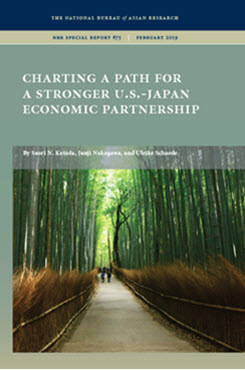Foreword: Charting a Path for a Stronger U.S.-Japan Economic Partnership
This is the forward to the NBR Special Report “Charting a Path for a Stronger U.S.-Japan Economic Partnership.”
When the United States withdrew from the Trans-Pacific Partnership (TPP) in January 2017, it abruptly shifted U.S. economic and foreign policy strategy in the region and introduced uncertainty in the U.S.-Japan economic relationship. Two years later, the business and policy communities in the United States and Japan are still grappling with this change in course and asking where they go from here. This report brings together three of the top experts on U.S.-Japan economic relations to answer that question.
The strong U.S.-Japan partnership has been a stabilizing force in the Asia-Pacific for decades, and now the two nations are entering a new era in their trade relationship. Japan has stepped up its leadership in the region by spearheading the Comprehensive and Progressive Agreement for Trans-Pacific Partnership (CPTPP) as a high-standard alternative to the TPP without the United States. Meanwhile, the United States has moved away from multilateral deals and is pursuing a narrower bilateral trade agreement with Japan.
In light of these changing dynamics, the National Bureau of Asian Research (NBR), in collaboration with the Ministry of Foreign Affairs of Japan, convened a workshop in Seattle in September 2018 with two-dozen experts to explore how the United States and Japan can strengthen their economic relationship post-TPP. This report is a result of those discussions and includes original, independent research and analysis.
In the first essay, Saori Katada examines the use of economic statecraft by China, Japan, and the United States to project power and shape the region according to their interests. Although Japan had preferred to work with the United States to establish high-standard trade rules for the region, Katada argues that uncertainty over the U.S. commitment to multilateral trade frameworks has prompted Japan to increase its role in maintaining the liberal regional order while engaging in a hedging strategy with China. At the same time, China is aggressively pushing an agenda to cement its own sphere of influence, and norms of regional order for the last 50 years are being contested.
Ulrike Schaede’s essay delves into the implications of the U.S.-China trade war for Japan. Schaede analyzes Japan’s past and present economic relations with the rest of Asia and the United States and demonstrates that Japan has diversified its trade relationships away from the United States to countries across Asia. China is now Japan’s largest trade partner. As a result, U.S. actions such as withdrawing from the TPP, imposing tariffs on Japanese steel, threatening tariffs on automobiles, and engaging in a trade war with China risk moving Japan closer toward China and other trade partners in Asia and the European Union.
In the final essay, Junji Nakagawa considers what a U.S.-Japan bilateral trade agreement could look like and ultimately argues that such an agreement will be too narrow to truly address both the U.S. and Japanese interests in the region. He argues that the United States returning to the TPP or joining CPTPP would be the preferable response to China’s push for the lower-standard Regional Comprehensive Economic Partnership (RCEP) to establish the economic framework for the region.
Taken together, these essays suggest that it is in the United States’ immediate and long-term interest to prioritize its economic relationship with Japan and continue to promote a rules-based, liberal economic order for the Asia-Pacific. With China actively pushing its own values and rules through RCEP, its Belt and Road Initiative, and other initiatives such as the Asian Infrastructure Investment Bank, the U.S. response must be comprehensive and strengthen coalitions of regional partners. The United States has taken a step in this direction with its new Indo-Pacific economic vision, and in 2019 attention to economic strategy in this region must rise to the highest levels of foreign policy priorities.
I would like to thank Japan’s Ministry of Foreign Affairs and the Consulate General of Japan in Seattle, including Consul General Yoichiro Yamada, Ayako Tsuyada, and Takeshi Murazawa, which made the September discussion possible. I also extend special thanks to the workshop panelists Charles Boustany, Saori Katada, Junji Nakagawa, Ulrike Schaede, Kenneth Pyle, Takashi Terada, and Toshiya Tsugami. Finally, I am grateful to my NBR colleague Meagan Araki for helping the workshop run smoothly and to NBR’s publications team for their skillful editing of this report.
Ashley Dutta
Senior Director, Center for Innovation, Trade, and Strategy
The National Bureau of Asian Research



